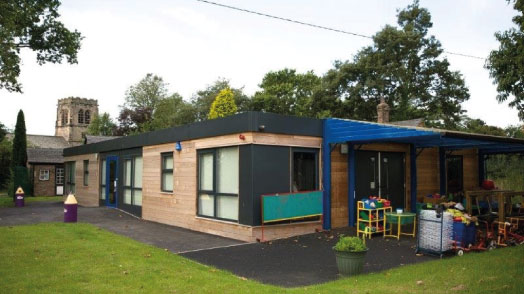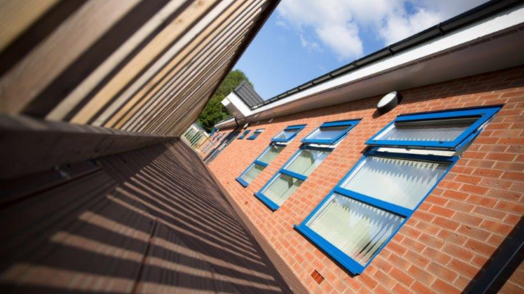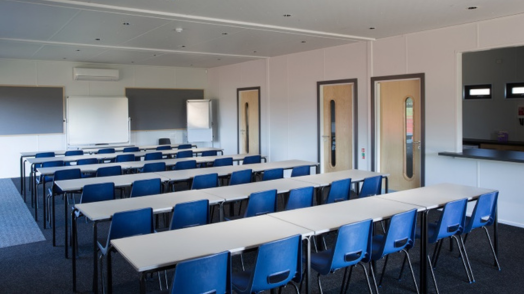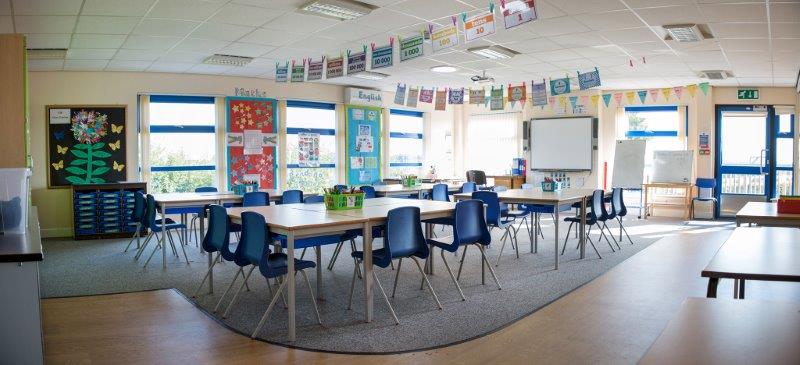Contact our friendly team for more information on our full range of buildings and how to start the process of hiring or buying a modular building for your business. Our expert team is always available to give advice, guidance or support.
Published: 18 October 2024 in Building Types
The Green Revolution: How Modular Buildings Are Leading the Sustainability Charge

As the effects of climate change become increasingly evident, the demand for sustainable solutions has taken centre stage in every industry. Construction, which historically has been a major contributor to global carbon emissions and resource waste, is now undergoing a dramatic shift. Modular buildings, once viewed as a niche solution, are emerging as a leading force in the green revolution. These structures represent a modern, efficient, and environmentally friendly alternative to traditional construction methods, offering substantial benefits for businesses, schools, and organisations looking to build responsibly.
A Sustainable Construction Process
One of the defining features of modular construction is its precision. Traditional building projects often result in substantial material waste –scrap wood, excess concrete, and unused steel frequently pile up at construction sites. Modular buildings, on the other hand, are constructed in a controlled factory environment where every piece of material is measured and utilised to exact specifications. This level of accuracy dramatically reduces waste, with some reports suggesting that modular construction can cut material waste by up to 90% compared to traditional methods.
The factory setting also contributes to energy efficiency. In traditional builds, on-site work is often prolonged due to weather delays or coordination issues, leading to higher energy consumption for lighting, machinery, and transportation. By conducting the majority of work off-site, modular construction significantly reduces the energy required. Modules are built in a single location with optimised processes, and once completed, they’re transported to the final site in fewer, more consolidated trips. This streamlined approach not only reduces emissions but also limits disruptions to the surrounding environment, an important factor for schools and urban projects.
Eco-Friendly Features in Modular Design
Sustainability extends far beyond the construction phase. Modular buildings are often designed with energy efficiency and environmental impact in mind, incorporating features like high-quality insulation, energy-efficient windows, and even renewable energy systems such as solar panels. These features help reduce long-term energy consumption, making modular buildings not only a greener choice but also a more cost-effective one over their lifespan.
In addition to operational efficiencies, modular buildings are designed to evolve; their adaptability is a significant advantage in a world where needs are rapidly changing. Unlike traditional buildings, which are often static and inflexible, modular structures can be reconfigured, expanded, or even relocated to suit requirements. For example, a modular classroom initially used to address a temporary surge in student numbers can later be repurposed as office space or community centres. This level of reusability dramatically extends the lifecycle of the building, preventing the environmental costs associated with demolition and new construction.
Reduced Environmental Impact On-Site
Traditional construction sites are often noisy, crowded, and disruptive, creating challenges for neighbouring communities and ecosystems. Modular construction reduces these issues by shifting most of the work off-site. On-site assembly of modular buildings is quick and efficient, minimising heavy equipment use, noise pollution, and site disturbances. For schools or nurseries, this means far less disruption to daily operations – a crucial consideration when construction is needed during term time.
Another benefit is the preservation of green spaces. Modular construction requires less storage space for materials and equipment, leaving more room to maintain natural surroundings. This is particularly valuable for schools and organisations that prioritise outdoor areas for learning, recreation, or community use.
A Circular Economy Approach
One of the most exciting aspects of modular construction is its contribution to the circular economy—a system aimed at reducing waste and making the most of resources. Modular buildings are designed for disassembly, meaning their components can be reused or recycled at the end of their lifecycle. If a modular building is no longer needed, it can be sold, relocated, or repurposed, keeping valuable materials in use rather than discarded.
This approach benefits everyone involved. Schools, for example, can sell or rent out unused modular classrooms to other institutions, creating additional revenue streams while contributing to a more sustainable construction industry. For businesses, modular buildings offer the flexibility to adapt to changing needs without starting from scratch, saving time, money, and resources.
Modular Buildings as a Green Investment
Choosing modular construction isn’t just an environmentally conscious decision—it’s also a practical and economical one. With rising energy costs and stricter sustainability regulations, businesses and schools are under increasing pressure to reduce their carbon footprints. Modular buildings align perfectly with these goals. By investing in energy-efficient structures now, organisations can save on operational costs for years to come while meeting their environmental commitments.
In addition, modular construction supports local economies. Many manufacturers, including Springfield, operate in the UK, reducing the carbon emissions associated with long-distance transportation and supporting local job creation.
Building a Sustainable Future
The rise of modular construction marks a turning point in the way we think about building. It proves that we can address urgent space needs without compromising our responsibility to the planet. Whether it’s a classroom, office, or healthcare facility, modular buildings offer an innovative solution that balances practicality, cost-efficiency, and environmental stewardship.
At Springfield, we’re proud to be at the forefront of this movement. With over 50 years of experience, we specialise in creating high-quality modular buildings that prioritise sustainability without sacrificing functionality or style. If you’re ready to join the green revolution, contact our team today to learn how modular buildings can transform your space needs while helping to protect the planet for future generations!









